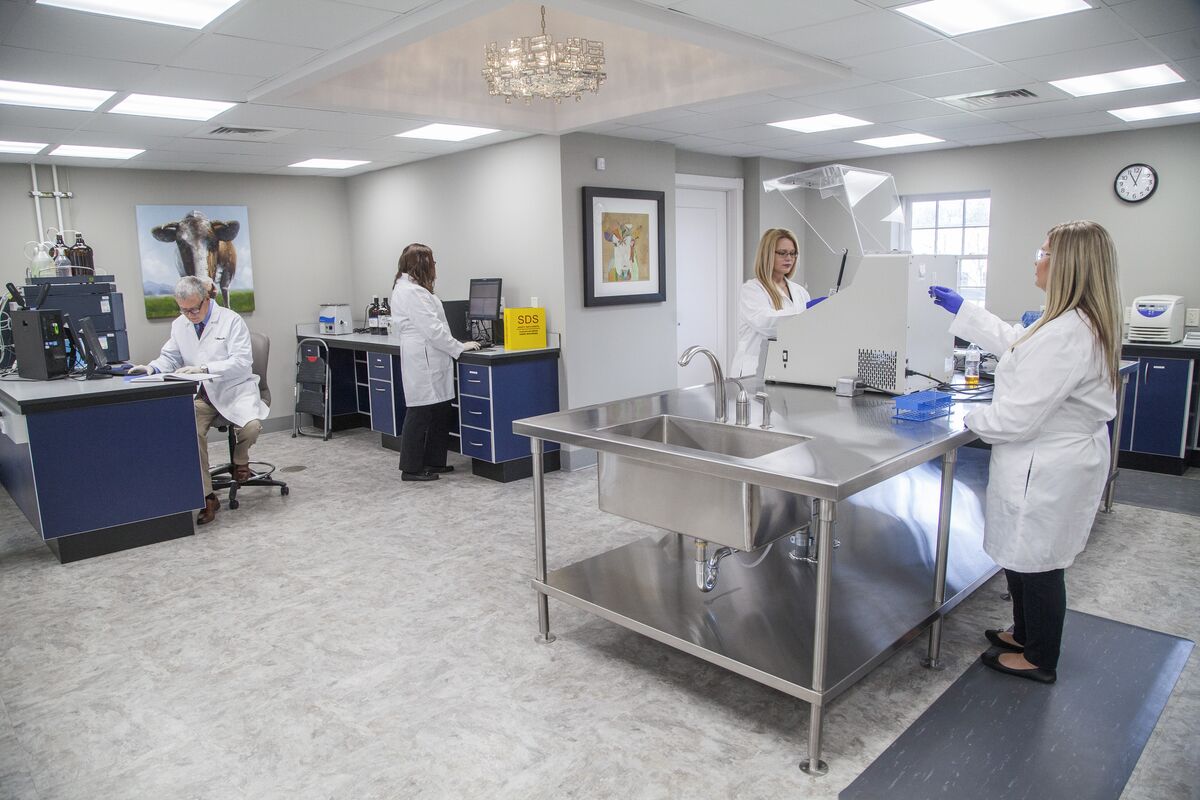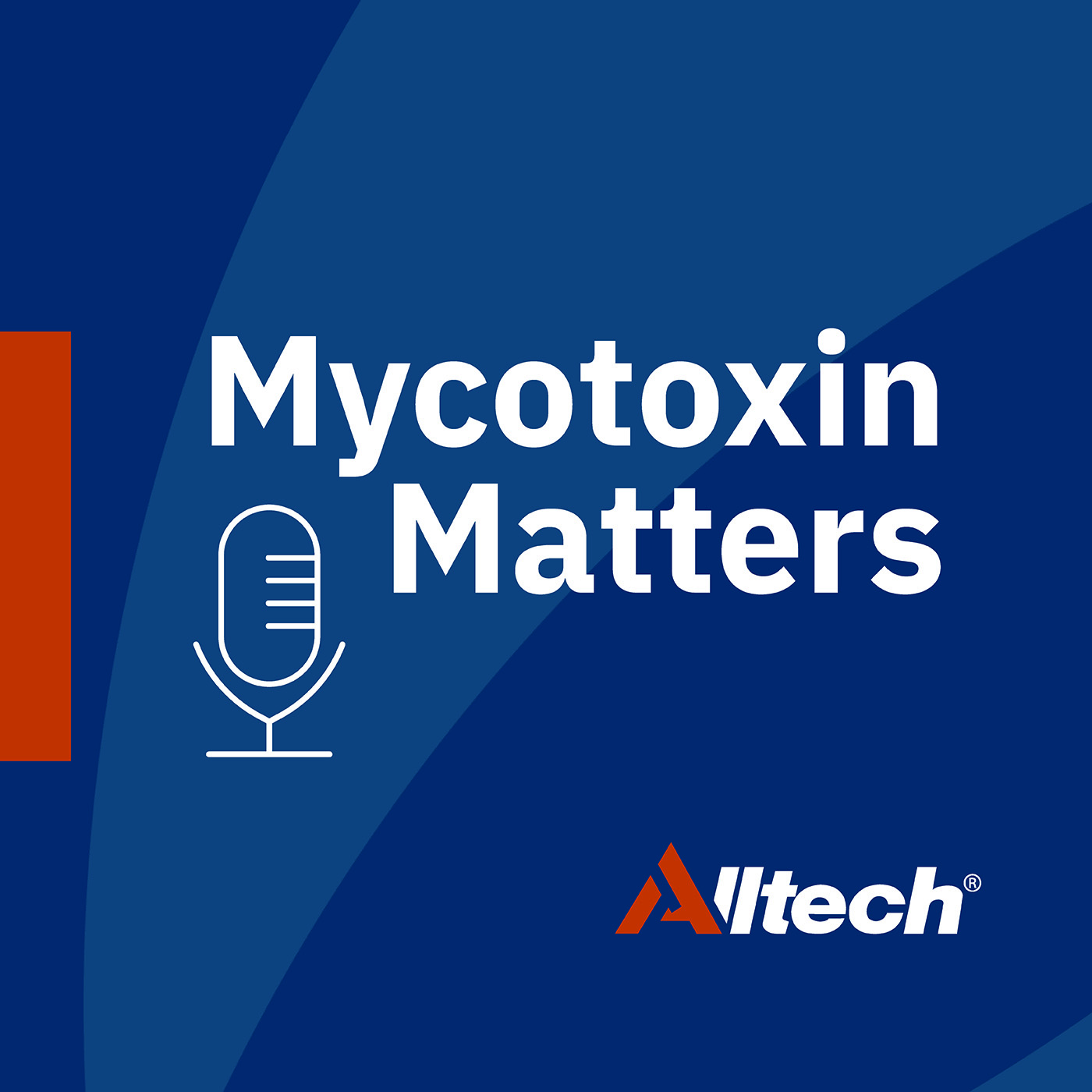Keep ahead of the threat
Stay up to date with the latest mycotoxin information by signing up to our newsletter

The evolution of mycotoxin control
Author: Martin Minchin | Mycotoxin Management Marketing Manager, Alltech
Click to listen to the Mycotoxin Matters podcast episode with Dr. Alexandros Yiannikouris and Dr. Manoj Kudupoje, hosted by Nick Adams. In this episode, they discuss the evolution of mycotoxin control and the pioneering research work that Alltech has carried out since being founded in the 1980s. You can also listen to the episode on Apple Podcasts or Spotify. You can find an edited transcript at the bottom of the page.
Although fungi and mycotoxins are likely to have been present since humanity first began to cultivate crops around 10,000 years ago, it is only in the last few decades that researchers have truly sought to understand these toxic compounds, both from an impact and control perspective in the feed and food chain. The discovery of aflatoxins, and the death of 100,000 turkeys in the UK in 1960, is primarily seen as the turning point for mycotoxin research.
Since Alltech was founded by Irish scientist and entrepreneur Dr. Pearse Lyons in the 1980s, it has been one of the companies pioneering mycotoxin research. Through both its in-house research team, led by Dr. Karl Dawson and Dr. Alex Yiannikouris, and alliances with universities and research institutions across the globe, over 170 peer-reviewed studies have been published to date, detailing a robust, multi-faceted exploration of mycotoxins’ impact on animal systems and their remediation.
Evaluating mycotoxin control strategies
It was recognised early on that building an effective mycotoxin mitigation program is not a simple process, mainly since there are almost always multiple toxins to deal with. Mycotoxins rarely exist in isolation, a fact continually demonstrated by mycotoxin testing at the Alltech 37+® mycotoxin analysis laboratory network. Across over 53,000 tests carried out in 10 years, the average number of mycotoxins per sample is 5.6. Alltech’s core expertise in yeast fermentation set the foundations for the research and development of yeast-based mycotoxin adsorbent technologies, with a specific focus on the cell wall extract of the Saccharomyces cerevisiae family. To determine how mycotoxins interact with bioactive constituents in the yeast cell wall (YCW) based binding technologies, Alltech’s research team and their partners typically employed three main evaluation techniques:
- In silico analysis: Defining stereochemical characteristics
This type of analysis uses computational approaches applied to molecular modelling, which provide a rapid screening process for evaluating the adsorption capabilities of glucan-based products.
- In vitro analysis: Defining product characteristics
Building on the in silico approach, in vitro-based laboratory assessment enables researchers to understand a product’s efficacy and large spectrum activity in scenarios where realistic contamination is present, either from chronic single or multiple-toxin exposure.
- In vivo analysis: Determining product efficacy in the animal
What works in the lab may prove less effective in the field. This is why in vivo trials are often seen as the benchmark for understanding true mycotoxin impact and product efficacy. This type of assessment allows researchers to understand the influence of multiple mycotoxins within the animal and the ability of a mitigation strategy to modulate these responses.
Utilising a range of evaluation techniques has allowed the Alltech research team to continually understand what carbohydrate structures need to be improved to enhance the binding characteristics of YCWE-based solutions, such as Mycosorb® and Mycosorb A+® — technologies that are tried and trusted by feed and livestock producers right across the globe.
Making the invisible visible
Adding to the complexity of the mycotoxin challenge in the animal feed supply chain is the fact that mycotoxins are invisible to the naked eye, leading to them being commonly referred to as “hidden thieves.” Traditionally, mycotoxins have been deemed elusive to detect; however, much has changed over the past decade. Increasingly, mycotoxins are more easily quantified, thus allowing a better understanding of their prevalence and potential impact on animal health and performance.
Arguably, the most significant advancement in this area was the evolution of mass spectrometry and the ability to use this to quantify the presence of many different mycotoxin molecules within a single feed matrix. This fundamentally changed the discussion around mycotoxin analysis, making it easier to detect lower levels of an increasingly broad spectrum of mycotoxins. While many academics had historically stated that naturally contaminated feeds were potentially more detrimental than feeding individual mycotoxins, now it was possible to describe in more detail the mycotoxin contamination profiles of feed ingredients, forages and finished feeds. Embracing the advancements in mass spectrometry techniques, Alltech opened its first Alltech 37+ laboratory in the US in 2012. Complementing the research work on the mode of action and broad-spectrum efficacy of YCWE adsorbents, the team now also had a method of detecting up to 37 individual mycotoxins across a wide range of grain-based feed ingredients, forages and TMRs. Since then, an additional 37+ lab has been opened in Ireland, while in China, a government collaboration allows for 37+ testing services to be provided in this important and growing animal feed market. Additionally, the panel of mycotoxins that can be detected has expanded and now sits at 54 individual toxins. Over 7,000 samples are tested each year across the 37+ network, generating more and more data for our teams and partners to understand mycotoxin contamination dynamics better.
Turning data into actionable insights
Making sense of the data and answering the question, ‘what does it mean for me?’ when it comes to mycotoxin levels in feedstuffs has been a fundamental objective of the Alltech Mycotoxin Management program for the past decade. The use of the risk equivalent quantity (REQ) metric, a measure of the cumulative presence of mycotoxins in a feed sample, has been key to understanding the challenge attached to multiple mycotoxin presence. Equally, understanding what certain mycotoxin risk levels may mean for a livestock producer in terms of physical and financial performance has ensured we can simplify what is often an abstract topic for farmers while also ensuring we are helping them to design and implement the most effective mycotoxin control program. Central to enhancing our data management and analysis is the Mycotoxin Management Portal, a secure online location where users can manage and assess their mycotoxin test data.
What does the future hold for mycotoxin research?
Reflecting what is such a dynamic challenge, research and innovation in the area of mycotoxins is continually evolving. Detection-wise, while some initial breakthroughs were centred on quantifying conjugated mycotoxins, attention has now turned to the so-called “emerging mycotoxins.” Mycotoxin test data highlights that mycotoxins, such as enniatins and beauvericin, that are produced by the Fusarium mould family are prevalent in certain grains and regions. Gaining more insights into their potential negative effects is, therefore, seen as a crucial objective.
Sustainability is now appearing in almost every conversation related to agriculture, and this is no different in the mycotoxin category. There are various dimensions to consider here, from the impact of mycotoxins on animal productivity and the subsequent environmental footprint of livestock systems to the role that a changing climate and environmental policies may play in determining future mycotoxin risk patterns. Will policies, such as The Green Deal, that are designed to enhance agricultural sustainability have the unintended consequence of increasing mycotoxin risk due to a reduction in the number of management tools available to producers, such as fungicides and deep tillage?
Although yeast and clay-based feed ingredients remain the dominant means by which producers mitigate the mycotoxin impact in the animal, researchers continue to evaluate new and novel mitigation solutions. Enzymes that degrade, or insects that metabolise specific mycotoxins are just two of the areas that continue to receive attention. To date, most of the work performed on insects and mycotoxins is to prove that insects, even when fed diets containing mycotoxins, can reduce their presence, potentially by biodegradation, and as such could represent a safe alternative protein source. Discussion around the potential metabolite formed and impact on an animal consuming such a protein source has not yet been at the forefront.
Using biomarkers as a measure of mycotoxin exposure is not a new phenomenon, although it is being talked about more and more in the industry. Finding the most appropriate biomarkers to measure has often been the challenge. With the exception of fumonisins, robust candidates have not yet materialised. Mycotoxins can result in unspecific and indirect changes in antioxidant and immune markers. Equally, these can be modified by many factors, including genetics, nutrition, pathogens, or environmental pressure. Although offering new ways to understand more about mycotoxins, challenges remain in validating the effectiveness and reliability of this technique, outside the research environment. The practical application of collecting biological fluids in a commercial setting may be difficult. Multiple mycotoxin contamination of feed is more common than not, and due to variation in metabolite profile, metabolization pathways, and excretion, it may be difficult to access multiple mycotoxin consumption through mycotoxin biomarker analysis. The relationship between biomarker, mycotoxin exposure and risk level has yet to be determined for most mycotoxins except for Aflatoxin M1 in milk.
Like sustainability, big data, machine learning and AI are terms that have become synonymous with conversations on the future of agriculture. From a mycotoxin viewpoint, industry and academia have a growing interest in how these technological advancements can be leveraged to enhance mycotoxin control. Over the last 10 years, models have been developed to predict what mycotoxin challenges may arise in certain geographies and crops. While still quite fragmented in their use and application, as tools like sensors and satellites become cheaper and more present in crop production, there is an expectation that more accurate prediction models will be developed. Combining data-driven decision-making tools throughout the growing season with mycotoxin prediction insights could offer crop producers and animal feed manufacturers exciting breakthroughs in assessing and controlling mycotoxin risk in the feed and food supply chain.
What we can say with some certainty is that the mycotoxin issue is not disappearing, and the next 40 years of mycotoxin-based research are likely to look very different from the previous four decades.








